
- Adobe InDesign CC - Home
- Desktop Publishing - Introduction
- Popular DTP Software
- InDesign CC - Introduction
- InDesign CC - Workspace Basics
- Create the First Document
- InDesign CC - Page Management
- InDesign CC - Section Options
- InDesign CC - Text Frames
- InDesign CC - Story Editor
- Spellchecking Features
- InDesign CC - Find/Change Function
- InDesign CC - Import Images
- InDesign CC - Image Links
- InDesign CC - Edit Images
- InDesign CC - Image Fitting
- InDesign CC - Image Transparency
- InDesign CC - QR Codes
- Selection Tools & Fill Strokes
- Image Color & Transparency
- InDesign CC - Drop Shadows
- Special Effects to Objects
- InDesign CC - Eyedropper Tool
- Find/Change Feature for Objects
- InDesign CC - Swatches Panel
- InDesign CC - Color Panel
- InDesign CC - Gradients & Blends
- InDesign CC - Paths & Outlines
- InDesign CC - Stack Objects
- InDesign CC - Layers
- InDesign CC - Nest Objects
- InDesign CC - Align Objects
- Text Wrap & Anchor Objects
- InDesign CC - Object Transformation
- InDesign CC - Characters
- InDesign CC - Text Formatting
- InDesign CC - Paragraph Formatting
- Paragraph & Character Styles
- InDesign CC - Tables
- InDesign CC - Long Documents
- InDesign CC - Table of Contents
- InDesign CC - Interactive Documents
- InDesign CC - Ebook
- InDesign CC - Preflighting
- InDesign CC - Package Documents
- Print Documents & Booklets
- Export Documents as PDFs
- Selective Text Frame Export
- Word & InDesign
- Word File Import to InDesign
- Word To InDesign
- Photoshop & Illustrator Workflows
- Export InDesign Artwork
- Preserve Layers & Vectors
Adobe InDesign CC - Page Management
Page management is important if you are dealing with a document having multiple pages. InDesign provides a lot of easy ways to insert, remove, or duplicate pages. Most of these functions are accessed from the Pages menu under the Layout main menu. However, we will use the Pages panel in the Panel Bar as it is much easier and intuitive.
The Pages Panel
We see that this document has two pages in two spreads. Clicking the Pages button on the Panel Bar opens the flyout showing various options that are possible with this document. Let us explore some of the options available in this panel.
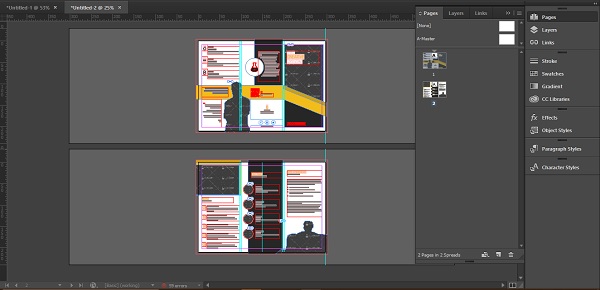
The bottom of the Pages panel has three buttons. The first button is called Edit page size. This lets you change the dimensions of the page, say from A4 to US Letter or A3. The second button is called Create new page. This allows you to create a page right next to the page currently selected in the Pages panel. The third button is called Delete selected pages and allows you to delete the selected pages.

You can create pages and re-arrange them simply by dragging and dropping them as desired within the Pages panel. You can also select multiple pages by pressing Ctrl on Windows or Command on Mac and selecting the desired pages.
Options in the Pages Panel
You can also make use of some more options to work with pages. Clicking the menu button on the Pages panel opens up a menu, which allows you to have more control over page management.
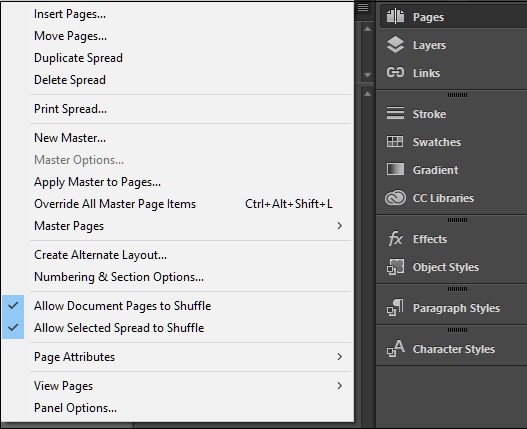
If you want to insert more than 1 page in the document, click the Insert Pages command in the menu. This opens up a dialog box wherein you can specify exactly how many pages you want to insert and where you want them to be inserted.
Say, for example, you want to insert a page after page number 2, specify them in this box to insert the page. You can also choose to insert the pages before, after, at the start, or at the end of the document.

If you want to move a page after a particular page number, you can use the Move Pages command in the same menu. You can specify the page number that you want to move and the page number that you want to either move after, before, or at the start or end of the document. Of course, you can also click and drag the pages to the desired position.
A neat feature is that you can also move pages from one open document to other.

Using the Page Tool
You can change the page dimensions of the pages in your document by going to the File menu and selecting Document Setup You can then specify your new Width and Height values here. Do keep in mind that all the pages in the document will be affected by this.
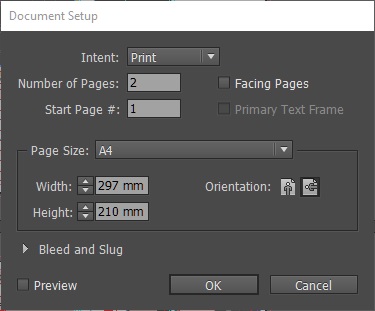
What if you wanted to change the dimensions of only a single page? The Page tool on the toolbar is your answer. You might want to change the dimensions of a specific page if you are preparing flyers or brochures that fold at specific pages. Using the Page tool is simple and straightforward but you must remember to set the correct reference point.

The above screenshot shows a two-page spread. If you look carefully, the first page on the left-hand side has some handles along its four sides. This is the indication that the Page tool is active on this particular page. Now, on the Control Panel at the top, you can specify your desired dimensions.

Remember the reference point, we discussed earlier? That is the left most button with the 9 small spheres. Each sphere is a reference from which the rest of the adjustments to the dimensions are made.
Say, for example, you want to reduce the page size towards the right, you would put a reference point in any of the left most spheres to ensure that the left part of the page is kept constant, while the right side is adjusted. This helps to avoid gaps in the page which can look out of place in the finished document.
Master Pages
A master page, like the name suggests, defines the overall layout of the document. Any changes to the size or number of pages on the master page affects the whole document. You can have any number of master pages, but the first master is called the A-Master. There is also a None master page which is devoid of the schema of the other master pages.
Master pages are very essential when working with books or magazines where the content flows from one page to the other.
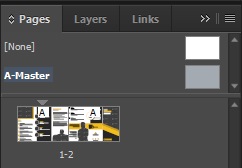
Clicking the Pages panel opens the flyout where you can select the A-Master and None master pages. Double-clicking on the A-Master opens the two-page spread master page which is basically blank. Notice that the individual pages in the panel show an A symbol. That means that the A-Master master page is applied to them.
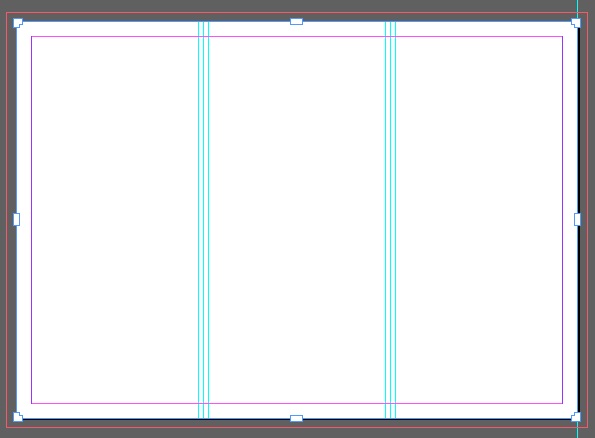
You can specify items on the master page such as header, footer, page numbers, or design layouts that would apply to all the other pages to which this master page is applied.
Dont want a master page element on any of your subsequent pages? No problem. Simply drag the None master page in the Pages panel onto your desired page to remove any master page defined layouts.
Creating Page Numbers
Creating page numbers in InDesign is easy. Since you would want the page numbers to appear on every page, you need to specify the location of page numbers in the master page.
Say, for example, you want to number the pages in a book. Open the master page as described earlier, and select a location for the display of your page numbers. Let us select the bottom of the page for this example and draw a text bar at the bottom by clicking the Type icon in the toolbar and dragging the textbox to the bottom of the page.
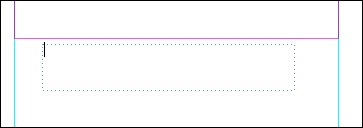
The key thing to remember is, you dont enter any actual numbers here. What you do is, tell InDesign that you want page numbers to appear in that position. To do that, go to the Type menu, go to Insert Special Character, then Markers and finally select Current Page Number. This will insert a symbol A in the textbox referring to the master page, A.
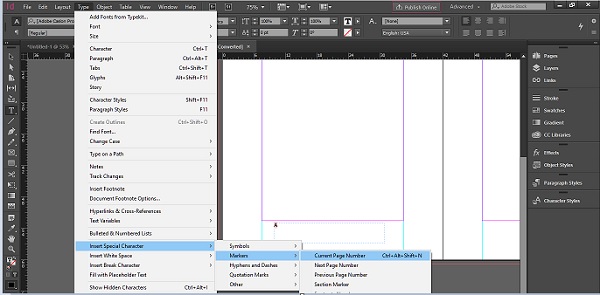
You can duplicate this page number textbox to the second page of the master page by holding down Alt + Shift on Windows or Opt + Shift on Mac and dragging the textbox to the same position on the next page.
Now, when you check the other document pages, you will have the page numbers at the exact position and with the same formatting youve specified in the master page.
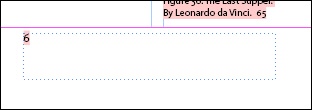
In the above document, it can be seen that InDesign has automatically designated page number 6 to the 6th page. Page number assignment is dynamic. As you add or delete pages, the numbers are adjusted automatically saving you the trouble of manually verifying them.